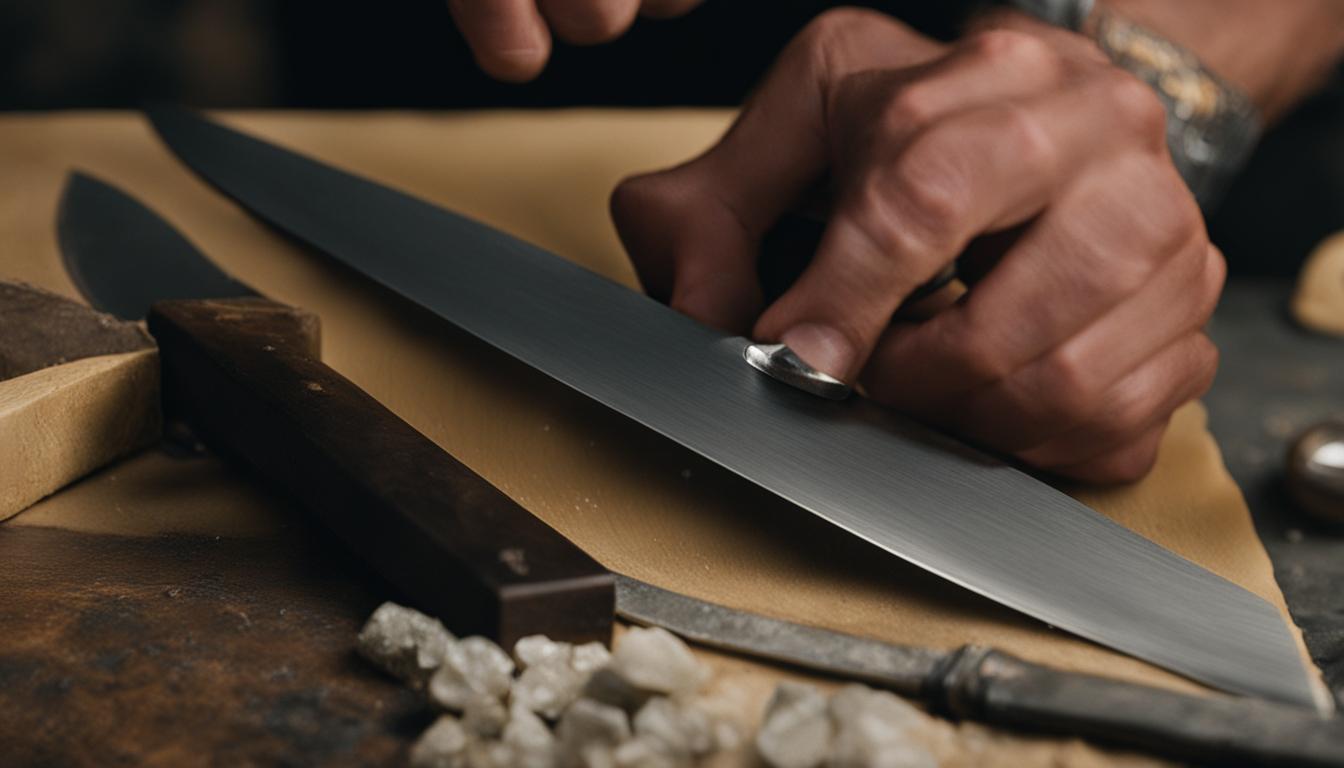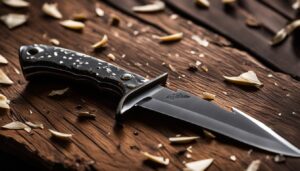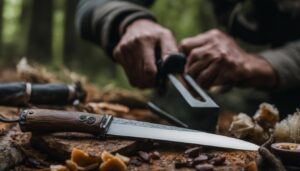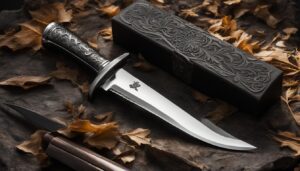In this comprehensive guide, I will uncover the secrets of hunting knife edge reconditioning and share techniques that will help you maintain and restore the razor-sharp edge of your hunting knife.
As a hunting enthusiast, I understand the importance of having a sharp and reliable knife in the wilderness. A dull knife not only slows you down but also compromises your safety. That’s why it’s crucial to know how to recondition and sharpen the edge of your hunting knife effectively.
Throughout this guide, we will explore various methods such as stropping and sharpening stones. These techniques will enable you to keep your blade in optimal condition, ensuring a precise and efficient cutting experience during your outdoor adventures.
Key Takeaways:
- Hunting knife edge reconditioning is essential for optimal performance and safety.
- Using techniques like stropping and sharpening stones can help you restore the razor-sharp edge of your hunting knife.
- Maintaining the sharpness of your hunting knife enhances its cutting performance and durability.
- Practice and experimentation will help you find the sharpening methods that work best for you.
- With dedication and knowledge, you can unleash the full potential of your hunting knife.
Understanding Stropping: The Final Step in Knife Sharpening
When it comes to hunting knife edge reconditioning and tool edge restoration, stropping is an essential technique that should not be overlooked. Stropping is the final step in the knife sharpening process, and it involves using a leather strop and micro abrasive compound to refine the knife’s edge to perfection. This technique helps to remove any residual burrs, polish the edge, and ensure a razor-sharp finish.
Stropping is a straightforward process, but it requires precision and attention to detail. The first step is to prepare the leather strop by applying a thin layer of the micro abrasive compound onto its surface. This compound helps in removing any microscopic imperfections on the knife’s edge. Next, the knife is held at the proper angle against the strop, and a consistent motion is applied to ensure even contact across the blade. The pressure should be firm but controlled to avoid damaging the blade.
“Stropping is an essential technique in the knife-sharpening process. It involves using a leather strop and micro abrasive compound to refine the knife’s edge to perfection.”
Stropping not only enhances the sharpness of the knife but also increases its overall durability. By regularly incorporating stropping into your knife maintenance routine, you can prolong the lifespan of your hunting knife and optimize its cutting performance. Remember, practice makes perfect, so don’t be discouraged if your first attempts at stropping don’t yield the desired results. With time and experience, you’ll become more proficient in achieving a razor-sharp edge through this technique.
Honing Guides for Stropping:
Here, we present a quick reference guide for honing hunting knives using stropping:
| Step | Instructions |
|---|---|
| Prepare the strop | Apply a thin layer of micro abrasive compound on the leather strop. |
| Hold the knife | Hold the knife at the proper angle against the strop. |
| Apply motion | Apply consistent and controlled motion along the length of the blade. |
| Repeat as needed | Repeat the stropping process until the desired sharpness is achieved. |
By following these honing guides, you’ll be well on your way to mastering the art of stropping and achieving a razor-sharp edge on your hunting knife. Remember, practice and patience are key to developing your stropping technique. Once you’ve experienced the precision and sharpness that stropping brings to your hunting knife, you’ll understand why it is considered an essential step in the knife sharpening process.
Selecting the Right Sharpening Tools: Sharpening Stones and More
When it comes to sharpening your hunting knife, selecting the right tools is essential. The right tools can make all the difference in achieving a razor-sharp edge and prolonging the life of your blade. In this section, we will explore different options for sharpening tools, including sharpening stones, guided sharpening systems, and benchstone knife sharpeners.
Sharpening Stones: Sharpening stones are a popular choice for knife enthusiasts and professionals alike. These stones come in a variety of grits, allowing you to choose the level of abrasiveness that suits your needs. Coarse grits are used for repairing damaged edges or reshaping the blade, while finer grits are used for refining and polishing. To use a sharpening stone, you’ll need to maintain the correct angle and apply consistent pressure as you glide the blade across the stone.
Guided Sharpening Systems: Guided sharpening systems are ideal for beginners or those who want a more foolproof sharpening process. These systems typically consist of a sharpening stone or diamond plate attached to a guide that ensures a consistent angle throughout the sharpening process. Guided systems eliminate the guesswork and provide a more controlled sharpening experience.
Benchstone Knife Sharpeners: Benchstone knife sharpeners are a convenient option for those who prefer a hands-free sharpening experience. These sharpeners utilize rotating wheels or belts that grind away metal from the blade, creating a sharp edge. Benchstone sharpeners are designed for quick and efficient sharpening, making them suitable for regular maintenance and touch-ups.
Comparison Table: Sharpening Tools
| Sharpening Tool | Features | Benefits |
|---|---|---|
| Sharpening Stones | Available in various grits, versatile, precise | Allows for custom sharpening, suitable for different blade types, offers control and precision |
| Guided Sharpening Systems | Consistent angle, user-friendly, reduces human error | Ensures a uniform edge, suitable for beginners, provides a guided sharpening experience |
| Benchstone Knife Sharpeners | Hands-free operation, quick sharpening, efficient | Convenient sharpening solution, time-saving, suitable for regular maintenance |
Choosing the right sharpening tools for your hunting knife ultimately depends on your experience level, preference, and desired sharpening outcome. Consider the type of blade you have, the level of control you want, and the time you’re willing to invest in the sharpening process. With the right tools and proper technique, you can restore and maintain the sharpness of your hunting knife for years of reliable and efficient outdoor use.
The Science Behind Knife Sharpening: Understanding Sharpness and Abrasion
Knife sharpening is more than just a simple task; it is a blend of art and science. To truly restore and maintain the razor-sharp edge of your hunting knife, it is essential to understand the science behind sharpness and abrasion. By delving into the microscopic structure of a blade and exploring the different sharpening techniques, you can unlock valuable insights that will enhance your sharpening skills.
The Structure of a Blade
Before we delve into the science of knife sharpening, let’s briefly explore the structure of a blade. A knife’s cutting edge consists of a series of microscopic teeth or serrations. Over time, these serrations become dull and misaligned, reducing the knife’s cutting efficiency. Sharpening the knife involves realigning these teeth to create a clean cutting edge, removing any burrs and imperfections that hinder optimal performance.
Abrasion Patterns and Techniques
When it comes to sharpening techniques, different methods produce distinct abrasion patterns on the blade. Whetstones, for example, create a series of tiny scratches that gradually refine the cutting edge. Electric sharpeners, on the other hand, employ rotating abrasive belts or discs to achieve similar results. Manual sharpening techniques such as stropping with leather compounds create a smoother, polished edge. Understanding these abrasion patterns will help you choose the most suitable technique for your hunting knife.
| Sharpening Method | Abrasion Pattern |
|---|---|
| Whetstones | Series of small scratches |
| Electric Sharpeners | Rotating abrasive belts or discs |
| Manual Sharpening (Stropping) | Smooth, polished edge |
By understanding the science behind knife sharpening, you can make informed decisions on how to restore and maintain the sharpness of your hunting knife. Whether you prefer the precision of whetstones, the convenience of electric sharpeners, or the control of manual sharpening, the key is to experiment, practice, and find the methods that work best for you. With dedication and knowledge, you can unlock the full potential of your hunting knife and ensure it is always ready for your outdoor adventures.
Mastering Manual Sharpening: Using Whetstones for Knife Sharpening
When it comes to restoring the razor-sharp edge of your hunting knife, mastering the art of manual sharpening using whetstones is essential. Whetstones, also known as sharpening stones, are versatile tools that allow you to achieve a finely-honed edge through a controlled and precise process.
Using whetstones for knife sharpening requires selecting the right abrasive grits and maintaining the correct angle while sharpening. A lower grit stone, such as 200 or 400 grit, is ideal for repairing seriously dull or damaged blades. As you progress to higher grit stones, such as 800 or 1000 grit, you’ll refine the edge and enhance its cutting performance.
When sharpening with a whetstone, it’s crucial to maintain a consistent angle throughout the process. Typically, a 20-degree angle is suitable for most hunting knives. However, if you have a blade with a different bevel or angle, adjust accordingly. Remember to apply consistent pressure and use a steady motion while gliding the knife across the stone.
| Whetstone Grit | Recommended Use |
|---|---|
| 200-400 grit | Repairing dull or damaged blades |
| 800-1000 grit | Refining the edge |
| 3000-6000 grit | Finishing and polishing |
By mastering the technique of manual sharpening using whetstones, you’ll be able to achieve a superior level of sharpness for your hunting knife. The controlled and hands-on approach allows you to sculpt the perfect edge, enhancing the cutting performance and durability of your blade. Remember to practice and experiment to find the right combination of grits and angles that work best for you.
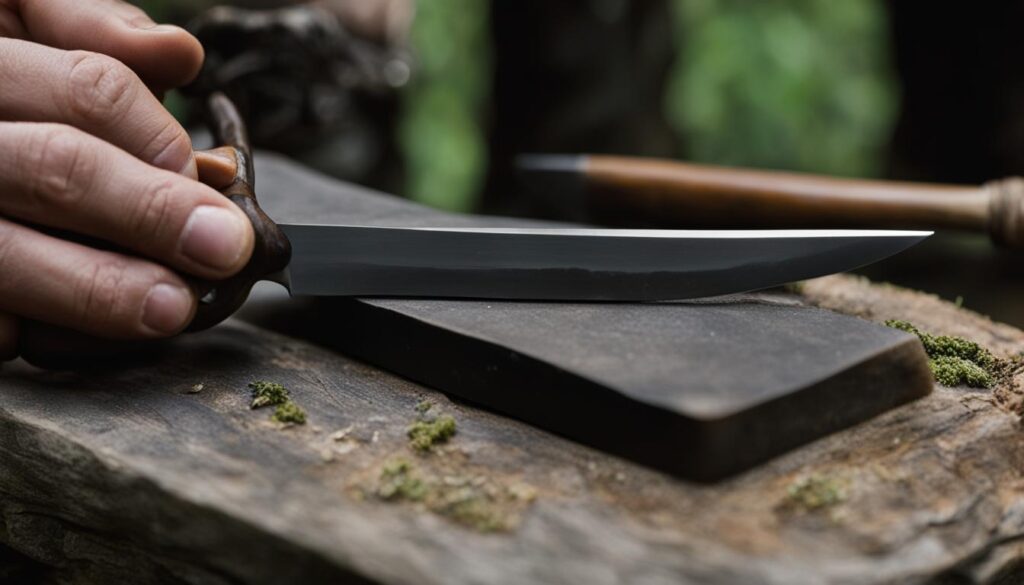
Expert Tip: Ensuring Proper Angle
“One of the most common mistakes in manual sharpening is failing to maintain a consistent angle. To ensure a razor-sharp edge, use an angle guide or practice with a marker on the blade to monitor your progress. This will help you maintain the correct angle and achieve optimal results.”
Electric vs. Manual Sharpeners: Choosing the Right Method for Your Hunting Knife
When it comes to sharpening your hunting knife, you have two main options: electric sharpeners and manual sharpeners. Each method has its advantages and disadvantages, and it’s important to choose the right one for your needs. Let’s take a closer look at the differences between these two sharpening methods.
Electric Sharpeners: Electric sharpeners are known for their convenience and speed. They are designed to quickly and efficiently sharpen your hunting knife with minimal effort. Electric sharpeners typically have built-in guides and automatic angle adjustments, making them user-friendly for beginners. They are also suitable for sharpening larger blades and can handle various types of knife steels.
Manual Sharpeners: On the other hand, manual sharpeners offer more control and precision. They allow you to adjust the angle and pressure according to your preference, resulting in a custom edge. Manual sharpeners, such as whetstones or guided sharpening systems, give you the opportunity to develop your sharpening skills and technique. They are also portable and don’t require electricity, making them ideal for outdoor use.
Ultimately, the choice between electric and manual sharpeners depends on your personal preferences and priorities. If you value convenience and speed, an electric sharpener may be the right choice for you. However, if you enjoy the process of sharpening and want more control over the edge, a manual sharpener is a great option. Consider your needs and preferences to make an informed decision and ensure your hunting knife is always sharp and ready for action.
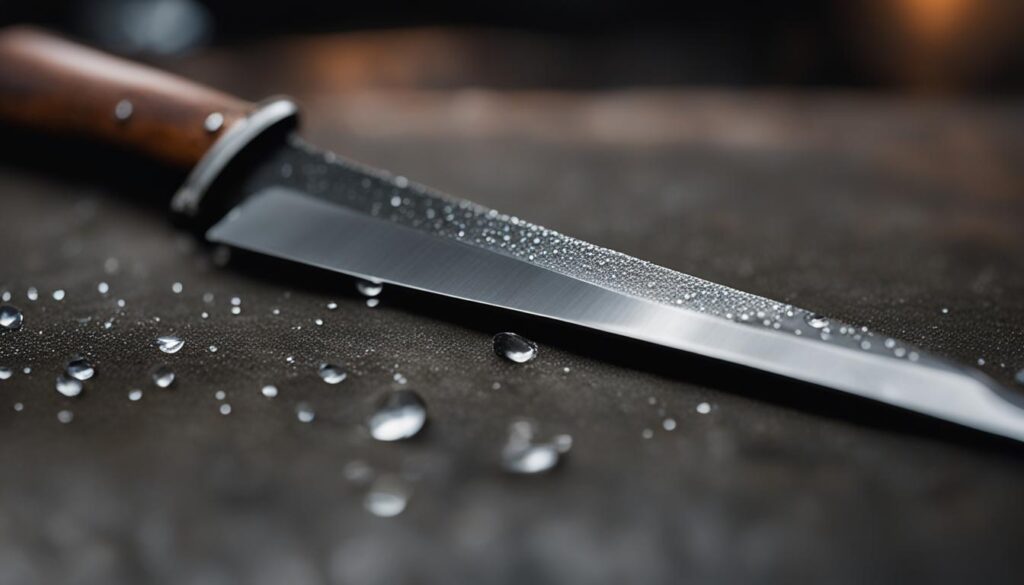

| Electric Sharpeners | Manual Sharpeners |
|---|---|
| Convenient and fast | Offers more control and precision |
| Automatic angle adjustments | Allows for custom edge |
| Suitable for larger blades | Develop sharpening skills |
| Easy to use for beginners | Portable and versatile |
Conclusion
Restoring and maintaining the razor-sharp edge of your hunting knife is crucial for optimal performance and safety. Throughout this guide, I have shared various techniques and tools to help you achieve this goal. From stropping to sharpening stones and electric and manual sharpeners, you now have a range of options at your disposal.
By implementing the tips and techniques outlined in this guide, you can ensure that your hunting knife remains sharp and ready for any outdoor adventure. Remember to practice and experiment with different methods to find what works best for you. With dedication and knowledge, you can unleash the full potential of your hunting knife.
I hope this guide has provided you with valuable insights into hunting knife edge reconditioning, blade honing, and knife sharpening. Now, armed with this knowledge, go forth and keep your hunting knife in peak condition. Happy sharpening!
FAQ
What is stropping and how does it help restore the edge of a hunting knife?
Stropping is a technique that involves using a leather strop and micro abrasive compound to refine the knife’s edge. It helps achieve a razor-sharp edge on a hunting knife by removing any burrs or imperfections.
What materials are needed for stropping?
To perform stropping, you will need a leather strop and a micro abrasive compound. The leather strop provides a smooth surface for refining the edge, while the compound enhances the sharpening process.
How do I properly perform stropping on a hunting knife?
To achieve optimal results while stropping, it is essential to maintain the proper angle, motion, and pressure. The angle should match the original bevel of the knife, and the motion should be consistent and controlled. The pressure applied should be firm but not excessive.
What are the different options for sharpening tools?
There are various options for sharpening tools, including sharpening stones, guided sharpening systems, and benchstone knife sharpeners. Each option has its own features, benefits, and methods of use.
How does sharpness impact the cutting efficiency and safety of a knife?
The sharpness of a knife significantly affects its cutting efficiency and safety. A sharper blade requires less force to cut through materials, reducing the risk of slipping and causing accidental injuries.
What is the microscopic structure of a blade, and how does sharpening eliminate burrs?
The microscopic structure of a blade consists of tiny peaks and valleys. When a knife dulls, small burrs are formed on the edge. Sharpening techniques remove these burrs and create a clean cutting edge, restoring the sharpness of the blade.
What are the different abrasion patterns produced by sharpening methods?
Sharpening methods such as whetstones, electric sharpeners, and manual techniques produce different abrasion patterns on the blade. Understanding these patterns can help you choose the most suitable method for your desired sharpening result.
How do I properly use whetstones for manual sharpening?
When using whetstones for manual sharpening, it is important to select the right abrasive grits and maintain the correct angle. The proper technique involves consistent and controlled motion to achieve a razor-sharp edge on your hunting knife.
What are the pros and cons of electric and manual sharpeners?
Electric sharpeners offer convenience and speed, while manual sharpeners provide more control and adaptability. The choice between the two depends on your personal preferences and specific needs.
How can I ensure the sharpness of my hunting knife is restored and maintained?
By following the tips and techniques outlined in this guide, such as stropping, using sharpening stones, or electric and manual sharpeners, you can ensure that your hunting knife remains sharp and ready for any outdoor adventure.
What is the key to successful knife sharpening?
The key to successful knife sharpening is practice and experimentation. By dedicating time to sharpening your hunting knife and trying different techniques, you can find the methods that work best for you and achieve the optimal edge sharpness.
